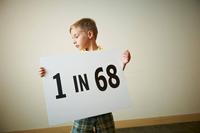#OneBookWednesday: Exploring Myths and Facts about the Autism Spectrum
By Will T.Emphasizing the diversity and individuality expressed on the Autism Spectrum was one of the main themes that came out of the One Book, One Philadelphia panel discussion hosted at the South Philadelphia Library last Wednesday entitled "Exploring Myths and Facts about the Spectrum." Author Mark Haddon deliberately avoids diagnosing his central character with any specific medical label. Is Christopher autistic? Does he have Asperger’s Syndrome? By avoiding labels, Haddon keeps us from perceiving Christopher as just a collection of clinical symptoms, but as an individual, albeit one who experiences the world a little differently.
The panel at our event was sponsored by the Center for Autism Research (CAR), and was targeted toward anyone who sees some of Christopher in their friends or family, or who just wanted to know more about how people on the Spectrum experience the world. And now is as good a time as any to learn more: the frequency for autism has expanded drastically in the last few generations, with 1 in 68 children currently being diagnosed with an Autism Spectrum Disorder (ASD). Judith Miller, a psychologist for the Children’s Hospital of Philadelphia (CHOP) and Clinical Training Director at CAR, began by giving an overview of the spectrum, which is defined by two overarching traits: difficulty with social interaction, and obsessive and / or repetitive behaviors. These two traits combine in multiple ways, each to varying degrees.
After Dr. Miller’s remarks, the panel took questions from the audience. Dr. Amanda Bennet, a pediatrician with CHOP and the site director for Autism Speaks, gave examples from her clinical experience. Marc Davies, whose son has Asperger’s Syndrome, gave personal testimony on having a close family member with the syndrome, a difference in perspective and dealing with situations that can be frustrating for both sides. Nancy Minyanou and Andrew Taylor are both self-advocates, and they were present to give their take on how both the book portrays ASD, as well as the general presentations and stereotypes so often seen in popular culture.
While everyone’s contributions were illuminating, Nancy made perhaps the most perceptive observation of the event: Too often, books and popular culture single out people with ASD as either comic relief or characters whose whole purpose for being is to overcome their ASD. But autism isn’t a sickness; it doesn’t have a cure. It is a part of who people are. Asked to give her favorite representation in media for a person with ASD, she gave Star Trek’s Spock, who sees the world through a hyper-rational framework and is often mystified by his crewmates’ more histrionic behavior. While the disparity between his responses and the crews can be played for laughs, we never see Spock as anything other than his Vulcan self, just like we don’t need to see Christopher as defined by any specific condition. The book and the panel reminded us that beneath the ASD traits, both Spock and Christopher are just people trying to get through the day. And isn’t that why we read fiction in the first place?
Have a question for Free Library staff? Please submit it to our Ask a Librarian page and receive a response within two business days.

